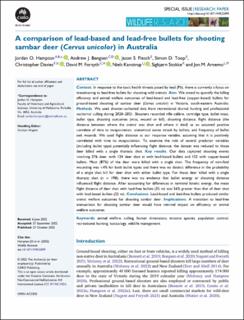| dc.description.abstract | Context. In response to the toxic health threats posed by lead (Pb), there is currently a focus on transitioning to lead-free bullets for shooting wild animals. Aim. We aimed to quantify the killing efficiency and animal welfare outcomes of lead-based and lead-free (copper-based) bullets for ground-based shooting of sambar deer (Cervus unicolor) in Victoria, south-eastern Australia. Methods. We used shooter-collected data from recreational diurnal hunting and professional nocturnal culling during 2020–2021. Shooters recorded rifle calibre, cartridge type, bullet mass, bullet type, shooting outcomes (miss, wound or kill), shooting distance, flight distance (the distance between where the animal was shot and where it died) as an assumed positive correlate of time to incapacitation, anatomical zones struck by bullets, and frequency of bullet exit wounds. We used flight distance as our response variable, assuming that it is positively correlated with time to incapacitation. To examine the role of several predictor variables (including bullet type) potentially influencing flight distance, the dataset was reduced to those deer killed with a single thoracic shot. Key results. Our data captured shooting events involving 276 deer, with 124 deer shot at with lead-based bullets and 152 with copper-based bullets. Most (87%) of the deer were killed with a single shot. The frequency of non-fatal wounding was <4% for both bullet types and there was no distinct difference in the probability of a single shot kill for deer shot with either bullet type. For those deer killed with a single thoracic shot (n = 198), there was no evidence that bullet energy or shooting distance influenced flight distance. After accounting for differences in terminal kinetic energy, the mean flight distance of deer shot with lead-free bullets (35 m) was 56% greater than that of deer shot with lead-based bullets (22 m). Conclusions. Lead-based and lead-free bullets produced similar animal welfare outcomes for shooting sambar deer. Implications. A transition to lead-free ammunition for shooting sambar deer would have minimal impact on efficiency or animal welfare outcomes. animal welfare, culling, human dimensions, invasive species, population control, recreational hunting, toxicology, wildlife management. | en_US |

